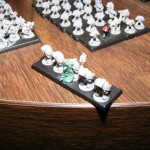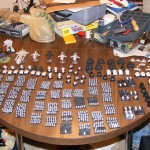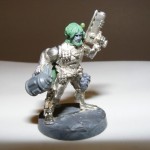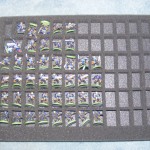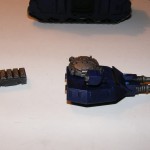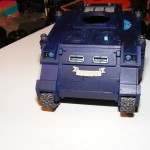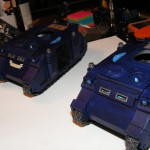Poindexta Smartyskull: The Ork with two Brains.
Conversion and Painting
A rather simple conversion, but a good one. I took Ghazgkull, sawed off the bottom of the cow-skull banner, and replaced the pole with a brass rod. I cut a brain shape and a lightbulb shaped skull out of plasticard. I then cut a smaller circle, to be the banner’s monocle.
For Smartyskull’s head, I had a square piece of plastic left over from a Trukk conversion. I coated this with putty, and put it on his left side of his head (seen on the right in the photo). I then filled out the other half of the head with a blob of putty that is much more rounded. I added some small sausages of putty to the front of the head, and flattened them slightly to make the veins.
The monocle is a simple Ork shoota crosshairs bit, with the insides and outsides smoothed. The chain is a thin strand of putty.
Smartyskull was painted using the same dipping technique seen in my dipping post.
Backstory
Dexa was just a regular boy until he unwittingly took a bolter round to the head for his Warboss. The Boss ordered the Dok and the Mek to rebuild Dexa’s head. Dok Gillgivva wanted to use a nice shiny Ork brain, put together piecemeal from those previous owners who hadn’t quite made it on the operatin’ table, and also to install some shiny new gills. Manik Upzindownz da Mad Mek wanted to try out a new cybork brain he had made from several good bitz, including the machine-spirit thingie from a Beekie Land Raider and his best pocketwatch. As Orks often do, they came to blows until the Boss broke them up and told them to work together or else he’d smash both of them good.
So they used both brains. They had to weld a lot of armour, and use a discarded skull here and there for spare bits of bone, but at the end, Dexa had a shiny new lightbulb shaped head. Dexa got a lot smarter after that, and intuitivley knew High Gothic, as well as gained an aptitude for strategy and logic. He was smarter than lots of sumboys!
After this the Nob of Dexa’s slugga boyz met with an “accident” when his power klaw “malfunctioned,” and Dexa took all of his stuff. Dexa grew in size, as Orks who challenge thier superiors do, until the boss noticed that Dexa was a threat to his power. Luckily for Dexa, he saw the boss sneaking up on him, sidestepped the Boss’ choppa, and shot the boss in the throat, then the head twice. The Boss’ most loyal Nob stepped up to give Dexa what for, and Dexa shot him point blank.
“Anybody else wanna ‘ave a go?” Dexa inquired. No one stepped forward. Dexa became the new boss and insisted on being called Poindexta. Due to his large cranium and his flair for strategy which led them to several successful raids, he earned the nickname Poindexta Smartyskull. He rules his tribe with a combination of low kunnin and head krumpin. He has most of the major tents or structures bugged, and bribes gretchin to be his (unreliable) eyes and ears. Lone dissenters are shot in the back or cut in half with a power klaw, and groups are incinerated by a loyal Burna boy. Poindexta Smartyskull leads his Blood Axe warband through the stars, trying to reconcile the conflict between the Ork part of his brain that loves a good fight, and the man-made computer that makes him insightful, witty, and urbane. He loves to take human prisoners because he needs someone to talk to, though his nobs often ruin the conversations by butting in.
Musings on Business Models: Part 2 – GW Specialist Games
In part one of my musings, I explained the pros and cons of the business model of the main line games of Games Workshop: http://fourstrandshobby.com/2011/01/27/musings-on-business-models-games-workshop-main-line-games/
To continue, I’d like to stay with the same company, but talk about their less often played games: The Specialist Games line.
First, a brief description. Earlier in the history of GW, they expanded from their two main line games into a plethora of other, smaller, side games. Among these are Epic Armageddon (formerly Epic 40,000), Battlefleet Gothic, Necromunda, Blood Bowl, Mordheim, and Warmaster. These were intended to provide additional revenue streams for people already engaged by the main line games. Sadly this did not work very well, as the games were not profitable enough to consider continuing. The games were retired to the archive, and control of the rules was handed to committees who revise the rules every three years.
Pros: Because the rules are decided by a committee if fans, and has a huge amount of fan input on several forums, problems with the rules get ironed out pretty well. Battlefleet Gothic has just had a rules update, and they clarified a number of inconsistencies in the rules, and made new rules that add to the gaming experience. The system is incredibly robust and useful, and the fleets are relatively balanced (except the Necrons). The Specialist model promotes game balance and a small but rabid online fanbase.
Cons: Most specialist lines have old models that, by modern standards, look dated. The Epic Armageddon Chaos Space Marine army is the best example of this. Most of the vehicles in the army have no model, and must be converted from other Epic lines. The infantry sprue contains several minis that do not exist in the game, such as Beastmen, Trolls, and Chaos Squats. These minis can be used with Epic’s wonderful “Counts As” rule in the Lost and the Damned list, but it would be nice to have all of the infantry in the army available for purchase.
Other examples include Necromunda gangs. Some have been updated (such as the snazzy new Orlock models) but some are much older (such as Cawdor) and it shows. It is unknown when, if ever, outdated gangs will get an update.
Next, Specialist Games do not promote expansion. Necromunda and Blood Bowl are the extreme examples of this. Once you have your Necromunda gang, and the resources to play (board, terrain etc.) you don’t need to buy anything else. This sounds like a pro to gamers, but it’s a con to the GAME. Games that are not expansive and don’t promote players getting bigger forces will not make as much money. You can have 12-15 ganger models and need nothing else to play Necromunda. In contrast, to play 40K, you need 40-100 models to play a medium sized game. Epic Armageddon requires many more minis, but they are small. Once you have a force that allows you to play a 6000 pt. game of Epic, you are in a pretty good position, especially if you have titans.
Finally, the Specialist model makes Specialist games expensive. The low demand makes the price point high, or else there would be no incentive for GW to even cast the old minis. The high prices are a bar for casual players. You can go to ebay, but this doesn’t solve the problem for GW, as they do not gain revenue if you buy a Blood Bowl team on ebay. Luckily, Blood Bowl box sets are one of the few Specialist Games items stocked in well-run local game stores.
Conclusion: Specialist games are fun and much more balanced than main-line games. However, they can be expensive to start, and don’t evolve or get new minis very often. If you are looking for a satisfying gaming experience that is not tournament based or hyper competitive, give Specialist Games a try.
The Star Systems of the Chasma Spica
The Star Systems of the Chasma Spica
An Astronomical and Geological Report by the Emperor’s Humble Servant: Magos Tukmehn Kelhar
Abstract
The Chasma Spica has long been closed to Imperial surveyors due to an ever-present Warp Storm. I had the fortune of being a guest aboard the Adeptus Mechanicus Explorator ship Menelaus during its discovery that the Warp Storm had dissipated. The Chasma Spica consists of a relatively dense region of space approximately 15 LY by 10 LY in the Segmentum Tempestus to the Galactic Southwest of Pavonis. It contains eleven previously recorded but unexplored Star systems. Surveys discovered that six of these systems have valuable planets. These six systems were renamed, to better identify them. Due to enemy presence, a full Geologic survey of each planet was impossible. However, with the assistance of the Azure Flames Adeptus Astartes chapter, data about each planet was gathered to the maximum degree possible.
Methods
Due to such a large number of star systems being explored in such a short period of time, the Azure Flames Adeptus Astartes Chapter assisted me by relaying their sensor data. They also launched several class theta probes to gain more information about each world. Long range sensors of the Menelaus were also used to gather information in several systems. Planetside surveys are impossible, due to unknown disposition of Chaos forces in the Chasma Spica. Several systems have very little data due to the interference of Enemy fleets.
Observations and Data
The Chasma Spica is a dense region of space. Systems are usually 2.4 to 3.8 LY from each other. The Warp storm encapsulated this entire region and an area 13 AU beyond it, denoted in previous star charts. Most of the systems are clustered around the Iperin system, with notable exceptions being the Tashka System and the CZ 184 system. Isotopic analysis of dust clouds in all eleven of these systems confirms that these nine clustered systems originated from the same parent nebula. Data collection was hampered significantly in the Je’lani and CZ 184 systems. Long range scans of these systems and brief sensor data are avaialble. Detailed observations will proceed from Galactic North to Galactic South.
CZ 184 is a Red Giant star class K. Observed surface temperature is 4,182 K. Luminosity is 2.43×10^28 Watts. No sattelites detected. Data are from long-range sensors only due to enemy interference.
Julius is a main sequence star class F. Observed surface temperature is 6,616 K. Luminosity is 4.47×10^27 Watts. Julius has three main satellites. Julius Alpha is .87 AU from Julius and has a radius of 5731 km. Due to the high temperature of Julius, and Julius Alpha’s proximity to it, and its small size, Julius Alpha has no detectable atmosphere. Tectonic forces are prevalent on Julius Alpha. Several volcanoes appear on its surface. Long-range laser seismographs aboard class theta probe indicate almost constant earthquakes. Julius Alpha is designated class delta, a dead world. Julius Beta is 1.61 AU from Julius and has a radius of 6,403 km. Julius Beta has a nitrogen-oxygen atmosphere consistent with alpha class agri-worlds. Julius Gamma is a Gas Giant 3.95 AU from Julius. Julius Gamma’s radius is 80,349 km. Julius Gamma has fourteen minor satellites. One of which, Julius Gamma Kappa, has a carbon dioxide atmosphere and frozen water. Currently classified delta tau, death world. The Julius system also has two Asteroid belts at 3.08 and 4.87 AU of light density. Most asteroids in the first belt are iron-chondrites. The second belt is composed of both iron-chondrites and ice.
CE 811 and CE 811 alpha are Binary stars orbiting each other. CE 811 is a main sequence class A with a surface temperature of 8231 K. Luminosity is 4.51×10^28 Watts. CE 811 alpha is a main sequence red dwarf class K with a surface temperature of 4090 K. Luminosity is 1.93×10^25 Watts. The CE 811 system is full of gas and dust clouds, possibly formed by extreme solar prominences during early collisions of the stars.
Je’lani is a main sequence class K with a surface temperature of 4432 K. Luminosity is 6.04×10^25 Watts. Je’lani has one satellite, Je’lani alpha, a Gas Giant at .74 AU. No further data due to destruction of probe by enemy incursion.
TU 32 is a White Dwarf class A with a surface temperature of 7743 K. Luminosity is 2.66×10^22 Watts. Large amounts of gas and dust clouds and asteroid fields indicate that TU 32 was much larger and went nova as it accreted a hypothetical gas satellite.
EQ 77 is a Red Dwarf main sequence class M with a surface temperature of 2973 K. Luminosity is 1.362×10^23 Watts. Asteroids and gas and dust clouds present in great amounts. EQ 77 was most likely a larger Red Giant that ran out of Helium and collapsed. It is currently fusing larger elements to stay lit. It does not have the mass required to collapse into a singularity. EQ 77 has one minor satellite, EQ 77 alpha, at 4.2 AU. It has an average radius of 1973 km. EQ 77 alpha is extremely irregular and completely uninhabitable.
Iperin is a main sequence star with a surface temperature of 5814 K. Luminosity is 1.034×10^26 Watts. The Iperin system has several satellites. Iperin Alpha is .709 AU out, and has a radius of 3107 km. Iperin Alpha has a thin CO2 atmosphere, similar to the proto-atmosphere of Mars. Infared readings and tectonic scans indicate no internal planetary energy; hence Iperin Alpha is classified as a class delta, dead world. Iperin Prime is 1.13 AU out and has a radius of 5,982 km. Despite the smaller radius, gravitometric scans indicate that surface G is approximately 1, which leads me to believe that the core of this world is slightly more enriched in Iron than Holy Terra. Magnetic readings unavailable. Atmosphere is a 65% N2, 18% O2, and 12% Argon, with variable other gases such as CO2 and water vapor. High-orbital photography indicates complex weather systems, two main continental masses, and a large planet-spanning ocean. Ice caps exist on both poles. The southern continent is also partially covered by ice. Tectonic scans indicate that this is a geologically active world. Iperin prime also has two moons, Iperin Prime Alpha and Beta, which orbit at distances of 10,342 km and 14,376 km respectively. Both moons are delta class dead worlds and have no atmospheres. Iperin Prime is designated alpha class. Iperin Gamma is 1.9 AU out and has a radius of 1,903 km. It has a thin atmosphere composed of CO2 and other trace gases, and is designated a class delta dead world. Iperin Delta is a gas giant 4.38 AU out, and has a radius of 80,311 km. Iperin Delta has an extensive system of rings, numbering approximately 483. Iperin Delta has several hundred moons, all of which are asteroids or delta class dead worlds with a radius of less than 1,500 km, except for one moon designated Iperin Delta Upsilon. This moon has a radius of 3142 km and has an atmosphere compsed of 32% water vapor, 54% CO2 and 10% O2 with other trace gases. Iperin Delta Upsilon has liquid oceans that undergo huge tidal action because of the moon’s proximity to Iperin Delta. This tidal action causes friction, which keeps the oceans liquid despite Iperin Delta Upsilon’s distance from its star. According to spectrographic scans, these oceans are rich with chloroplast bearing lifeforms which provide the oxygen component of the atmosphere. The carbon dioxide rich atmosphere means that human beings should wear CO2-scrubbing respirators while on Iperin Delta Upsilon. Several volcanic islands dot the moon’s surface, and tectonic sensors show incredible stress on the moon’s plates, probably due to the same gravitational shearing that cause it’s tidal action. Iperin Delta Upsilon is designated delta tau, death world, due to its treacherous shifting oceans, tectonic and volcanic action, and extreme temperatures. Iperin Epsilon is a gas giant 7.12 AU out, and has a radius of 58,984 km. It has a minor ring system numbering 13 rings, and has several moons, none of which are significant.
Veovis is a main sequence star with a surface temperature of 5,002 K. Luminosity is 7.9×10^25 Watts. The Veovis system has one primary satellite and several gas and dust clouds, and asteroid belts. Asteroid belts are located at 3.8, 4.7 and 8.2 AU out from Veovis. Veovis Alpha is a gas giant 1.83 AU out and has a radius of 97,313 km. Veovis Alpha has several moons, but only two moons of significance; Veovis Alpha Gamma and Veovis Alpha Zeta. Veovis Alpha Gamma is an iron-chondrite concretion approximately 847km in diameter. It has no atmosphere and is designated delta class, death world. Veovis Alpha Zeta is 1,382 km in diameter and has an atmosphere composed of 63% CO2, 23% water vapor, 12% H2SO4, and 8% complex hyrdocarbons. Seismic readings indicate minor tectonic activity. Long-range spectrographic scans identified several large bodies of liquid on the surface of Veovis Alpha Zeta consisting of various complex hydrocarbons. Veovis Alpha Zeta is classified delta tau, death world.
RY 9 is a white dwarf with a surface temperature of 9,382 K. Luminosity is 2.38×10^23 Watts. RY 9 has several gas and dust clouds, and scattered irregular asteroid fields.
Tashka is a giant with a surface temperature of 4,587 K. Luminosity is 1.87×10^28 Watts. The Tashka system has one major asteroid belt at 3.63 AU from the primary. Tashka has two primary satellites. Tashka Alpha is 2.65 AU out and has a radius of 2,982 km. Tashka Alpha has no atmosphere and is designated delta class, dead world. Tashka Beta is a gas giant 4.74 AU out and has a radius of 91,283 km. Tashka Beta has a ring system numbering 37 rings. Tashka Beta has five moons, the only significant moon of which is Tashka Prime. Tashka Prime has a radius of 4,782 km and has an atmosphere composed of 63% N2, 21% Argon, 12% O2, and other trace gases. The moon has several liquid oceans and consists of mostly volcanic archipelagoes with one major continent straddling the moon’s equator. Tashka Prime is classified lambda class, livable world.
Malkoth is a main sequence star with a surface temperature of 6,359 K. Luminosity is 1.6×10^26 Watts. Malkoth has asteroid belts at 4.3 and 11.6 AU. Malkoth also has extreme gas cloud distribution and random asteroid fields ranging from 6.9 to 7.3 AU out. Possibly remnants of two or more gas giants that collided or were torn apart somehow. Malkoth Alpha is 1.3 AU out and has a radius of 5,612 km. It has an atmosphere composed of 68% N2, 28% CO2, and other trace gases. Tectonic activity is minimal. Extensive life signs detected from orbit, type unknown.
Conclusions
The Chasma Spica has an incredible wealth of unexplored livable or exploitable worlds. Several of the dead worlds in a variety of systems would be perfect for class rho research stations. Julius Beta, Iperin Prime, Iperin Delta Upsilon, and Tashka Beta Delta are currently habitable by human beings. Julius Beta is the ideal candidate for an agri-world, but is too valuable for its cropland than for any other purpose. Iperin Delta Upsilon would be suitable as an agri-world if the local life proves nutritious, or if a suitable replacement can be introduced. Iperin Prime and Tashka Prime are the finds of a lifetime. Both are extremely earthlike and could be put to any number of purposes including Hive worlds. Malkoth Alpha could also become usable after terraforming processes alter the atmosphere. Veovis Alpha Zeta is a hazardous world, but the natural complex hydrocarbons in its atmosphere and oceans are ideal for refinement into promethium and other fuels. I recommend that Imperial forces seize control of the Chasma Spica at all costs.
Magos Tukmehn Kelhar
Magos Supremis Geologis
The Saratogan 58th, an army inspired by feminism.
So before the Big Game 5, Lexington (of aurorachapter.com) went to a con (I forget which one) and came back with pictures and stories. Lexington, myself, and our friend Lia were sitting around the living room in Lia’s house. Lexington lived in her house at the time.
Lexington tells us a story that he saw a Guard army made of female models. They were apparently all shock pink. The Ogryn had Marge Simpson beehive hairdos. They also apparently had other “girly” things like hearts and bunnies everywhere. The army was made by a guy. I thought that was cool from a conversion standpoint, because it would be really hard to do.
Lia disagreed. She explained that making a “girl” armed force all pink and frilly is saying that women serving in an armed force is silly. She said it was a joke, and the punchline is that women can’t serve in the military. She was right, that’s exactly what that army said under the surface. Later on that day, I tried to imagine: “What would a Guard army that WASN’T sexist look like?
The next thing that popped into my head was the motto of the Saratogan 58th: “If you can hold a lasrifle, you can die for the Emperor.”
It would be an integrated force, even more so than the United States army today. Women and men would fight side-by-side. Now, how to do this? There are no female models made by GW, except those that are either not human or ass-ugly. Here’s how I did it.
First, I found female faces from Privateer and Reaper minis that were not hell of ugly. I cut off these mini’s heads and filed the head down until it fit in the empty Cadian helmet.
Then I took five female Eldar Guardian torsos, and modified them to look Cadian.
I moulded these objects and made resin copies. I then used Green Stuff to fill in bubbles. I used normal Cadian arms and legs, but slightly filed to fit the new waist. About 50% of the models in the army will be female, for an integrated fighting force. The color scheme (seen on the painted model) is very ordinary. Female soldiers don’t wear pink. They wear standard Cadian drab green.
The backstory will be posted later. It is based on the 90’s science fiction show Space: Above and Beyond that apparently only I liked. Notice that on the painted mini (my Ursakar Creed stand in) that there are custom decals. These were expensive but WORTH IT.
New Battlefoam Case
Everyone’s seen my custom made Blue Tub case for the Azure Flames. I lug it around, opening doors with combinations of my foot, ass, and sheer determination. It’s been slowly damaging several models for a long time.
No More.
My Battlefoam case has arrived. Expensive but worth it if I never have to repair models because the case broke them. The main XL case has synthetic canvas covering a rigid plastic shell. Inside, the trays rest on top of each other snugly. There were too many Azure Flames to fit in an XL case (raise your hand if you’re surprised) so I had to get a second small case. This second case attaches to the first with a convenient zipper. The whole case has a set of wheels and an extendable handle for easy transportation one-handed. No more lugging around a tub! There are even pouches for books and other things along the sides.
No one can stop me.
Modular Space Marine Vehicles
In preparation for the Big Game 5, I decided to update all of my old Rhino Chassis vehicles. I called it the “New Rhino Chassis Project.” Going the extra mile, I wanted to save some money and make modular vehicles that could be ANY variant of the Predator tank, or a Whirlwind. Here’s what I did.
Two Rhino Chassis were given large Rare Earth magnets on the inside of their doors, and a Predator/Whirlwind top hatch. I then made Predator Side Sponsons and regular doors that were magnetized. Note that the magnet on the regular doors has since been replaced with a much smaller magnet, as it was near impossible to remove the door.
Next, the sponsons and Predator sponson guns were modified using Legos. This lets them fit together snugly without interfering with the other magnet. The Whirlwind Turrets were also modified with Legos so the regular and Castellan missiles could be switched out.
The Predator turrets were modified with magnets in a “clamshell” configuration to switch out the guns easily. The ammo boxes on the back have magnets as well, letting them fit on snugly without attaching permanently.
As a result these two tanks can be ANY variant. Las OR Autocannon Pred with HB or Las sponsons OR no sponsons. It could also be a Whirlwind with either of the two missiles.
Getting the Band Back Together
So one day my friend Scott came up to me and said “We’re doing another Big Game a year from now.”
I don’t know how to describe what I felt next because it was a new feeling. But it was awesome.
Here’s some history. Our old gaming group, Studio 40K, used to play in Mary Mayo hall. Every once in a while, we’d put on Big Games. The first and second Big Games took place on the floor of a pole barn on my friend Jake’s parent’s christmas tree farm. It was huge, but painful as we knelt on concrete for twelve hours. The third was on the 4th floor of the MSU Union, and then the fourth was back in the pole barn (because it was free). Players were divided onto the “good” and “evil” sides.
I had mixed feelings about the earlier games. In the first I wasn’t able to do much besides make Andy’s Necrons phase out, and one of our players was kind of screwed over. His name was also Andy and he played Dark Angels. He was told to take a 100% deep striking force, but was forced to deep strike within 24″ of an objective, so his army was essentially deployed randomly, piecemeal, in a useless place. He lost two units to the Perils of the Warp. We never saw him again. There was no fluff for this game, people just played.
In the Second big game, I was face-to-face with an outnumbering force of Eldar, and I had a mounted force ready to assault. Sadly, I was not allowed to move on turn 1, essentially turning my vehicles to tombs. The scenario also favored the “evil” side, as we had a Titan that was supposed to “march” to a city to liberate it. Unfortunately you can’t march if there’s an enemy within 48″ and the Evil side had John, a Tyranid player. His Lictors kept the titan from marching. This game had a backstory by Joe, that an evil artifact allowed Chaos to control other evil armies.
The third was essentially twelve small games going on at once. I faced John’s Tyranids across a “cornfield.” These were essentially forests that you could see 12″ into instead of 6″ like normal. However, John’s Tyranids could assault MORE than 12″. Half of my force retreated to help another board, but we had a lot of bad matchups. Guard vs. Necrons in the city could not pop Monoliths because they were hull down, and the Monolith blasted everything. Dan’s Tau marched (stupidly) right up Andy’s Necrons’ throat. Dave (former 21C manager) ran across a death field at an artillery heavy Iron Warriors army. Comedically there was ONE mismatch the other way. Brian’s Orks were trapped on the other side of a huge trench and were pounded by Damon’s Guard. Sadly the good guys had one guard plauyer whose name escapes me, and he was a huge cock the whole time. In this story, the evil sword from the first story continued to control the bad guys. It was now wielded by an Ork Warboss!
In the fourth, the game was much more balanced. In the end, Brian’s Ork bikers turned a Good Victory into a tie. I remember my knees being sore, and Scott almost died. The good guys really did not deserve to win, as we made several mistakes like deploying our Thunderhawk in the middle of the goddamn board. The evil sword was now in the hands of the nefarious Victor Kalan. His brother, Inquisitor Angmar Kalan, led the forces against him. To break the tie, Victor and Angmar fought close combat. They killed each other! A true tie!
So that’s where I thought it would have ended. Then Scott said that wonderful sentence. It led me to a year of some of the most intense creativity I have ever experienced. It also encouraged me to finish every little thing for the Azure Flames, including a bevy of named Captains.
Details on Big Game 5 to follow in a later post.
MOAR LEE-ZARD
Finished 7 more regular skinks and the skink star player Hemlock, who has the special rule Stab.
…can you tell which one has Stab?
Blood Bowl: The Konquata Monitors
Recently I got into Blood Bowl. I haven’t played a game (due to a traffic jam DAMMIT) but I have a serviceable team raring to go. We are the Konquata Monitors, a Lizardmen team. Here is an image dump:
As you can see, I have six Saurus Warriors, eight Skinks, and two Saurus Star players. The Saurus were made from Temple Guard with Saurus Warrior left arms and Tyranid Carnifex armor plates. The Skinks have Genestealer armor plates cut in half. Each half makes one shoulder pad.
For the star players, there were no open hands available in the Lizardmen line. So, I used a piece of putty, coated it with oil, and wrapped it around the fist. Then, I CAREFLLY removed the mould and flattened it out. This gave me straight fingers. I then moulded the fingers over and over until I got enough to do each hand. Each finger was cut out, trimmed, and putty was added to fill out the finger. Putty was also added to make new nails. The one on the flying base represents the Star Player Lottabottol, who has diving catch. The other is Sillibilli who has block.
In the Warhammer Fantasy world, the Lizardmen have recently conquered the island of Albion, which they call Konquata. Lord Kroak personally formed the Konquata Monitors out of Saurus and Skinks from the First Spawning from the newly made spawning pools on Albion. Their mandate is to dominate the sport of Blood Bowl to advertise that Albion will belong to the Lizardmen for all time.
Next up: more Skinks including Star Player Hemlock, and a Kroxigor modded with Trygon bits!
